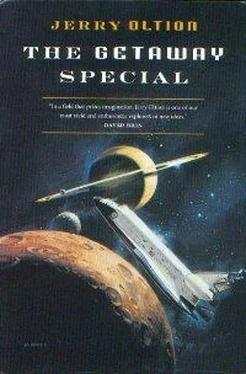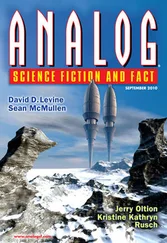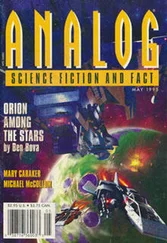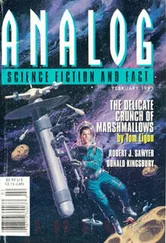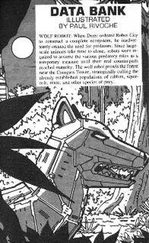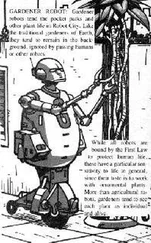“Very funny,” Judy said.
Allen looked out the window and grinned. “Good old inverse-square law. You’ve got to love it.”
Anybody who knew how to calculate an orbit knew the inverse-square law: the gravitational attraction of a given mass dropped off with the square of the distance from it. The same rule worked for light intensity, sound volume, and just about any other quantity that issued from a point source. Judy tried to imagine how it applied here. It was hard to think with Saturn just outside the window, but she forced herself to look away and concentrate on what Allen had said. “So did jumping to Saturn just now take more energy than the same distance in flat space, or did it take less because we were going downhill?”
Allen shook his head. “More. Apparently whenever you get near mass, it takes more energy to create the warp field, no matter which way you go. You’ve got to warp it twice, see, once at the point where you leave the normal universe and once where you drop back in.” He wrinkled his forehead, thinking, then said, “In fact, if it took less energy going toward a big mass, then we’d probably have wound up inside a black hole on our first jump.”
Judy winced at the thought, but Allen didn’t notice. He said, “The good news is, distance is just a minor factor in the equation, so as long as we don’t try jumping directly from planet to planet, we can make interstellar jumps without having to take along a nuclear reactor for power.”
“I thought you said you could jump directly from the surface into space.”
“You can. You just don’t want to go very far on the first jump, or it uses more energy. So you make a short jump to get outside the gravity well, then a long jump to someplace near where you want to go, then another short jump to land.
Well, actually a bunch of short jumps, because you can’t go all the way to the surface.”
“Why not?”
Allen had been waving his arms as he talked; he reached out to one of the remote video monitors to steady himself. “Two reasons. When you jump, you keep your initial velocity, so unless you match it perfectly with the spot on the ground you’re trying to land on, you’ll be moving when you get there. But the other reason is that you can’t appear where there’s already something in the way. Even air is too thick. So you have to appear outside the atmosphere and fall the rest of the way in with a parachute.”
“Or fly in,” Judy said. She looked out at the stump of the vertical stabilizer. Discovery wouldn’t be flying anywhere for a while.
She shuddered to think what would have happened if the A-sat weapon had hit the crew module instead of the tail. Or if they’d been just a few more minutes in repairing the hyperdrive, or if the space warp it generated hadn’t been big enough to take the whole shuttle along with it. They were lucky to be alive.
Saturn lured her attention again. Part of her, the little girl who’d dreamed of space travel, boggled at the sight, but the part of her who captained the space shuttle was thinking, He didn’t even know how it worked before he yanked us out of orbit .
Maybe knowing how many things could go wrong on a space flight made her paranoid, but the knowledge that Allen was flying by the seat of his pants didn’t inspire confidence. What if he’d missed something else equally obvious? In fact… “Wait a second. Are we outside Saturn’s radiation belts?”
“Radiation belts don’t extend over the poles,” he said.
“You’re sure?”
He nodded. “Relax. I know what I’m doing. And now that I know how to correct for mass, I can put us back in Earth orbit any time we want.”
Provided the hyperdrive didn’t burn out again. Judy imagined them falling into Saturn if it failed. Or would they starve first? How far away were they, anyway, and how strong was Saturn’s gravity at this distance? And even if they didn’t fall into Saturn, what about the unwanted velocity they’d picked up from their time near the Moon? Aloud, she said, “You don’t have any idea what our actual vector is, do you? Like you said, we could pop into the right place, but doing seventeen thousand miles an hour straight at the ground. Even if we start out a couple hundred miles up, that doesn’t give us much time to react.”
Allen looked out over Judy’s shoulder. He didn’t say anything for at least a minute, and when he did speak it was only to say, “We’re farther out than anyone has ever been. Seeing something nobody else has ever seen. Doesn’t that mean anything to you?”
The rings looked like tie-dyed silk. Specks of brightness just beyond them had to be the shepherd moons. Judy could almost hear the theme from 2001: A Space Odyssey playing in the background.
She shook her head and the music stopped. “Sure it does,” she said, “but it also means if something goes wrong, we’re dead. I’m just trying to keep that from happening.”
Carl chose that moment to float up through the hatchway, an even more worried than usual look on his face.
“What’s wrong?” Judy asked.
“We’ve got eight days of consumables,” he said, “but the toilet’s broken, and Gerry’s got to go. At least he says he does.”
“Oh, great.” The power of suggestion made Judy suddenly notice the pressure in her own bladder, too. She tried to ignore it, but she knew it wouldn’t be denied for long. Nor would Gerry’s. “Well, he’ll just have to use a waste bag,” she said. “For that matter, he’d have to use one anyway, because I’m not letting him loose again.”
Carl scowled. “We can’t keep him in that bunk forever.”
“We’re not going to. Allen is just about done here, and I think we’ve pushed our luck far enough for one flight. As soon as we’re sure it’s safe, we’re going back to the space station.”
“Good,” Carl said. He pulled himself down into the mid-deck again without even looking out the window.
Allen did. Judy found her gaze following his, once more drawn to the spectacle of Saturn floating just outside. The planet was half in light and half in shadow, the soft texture of its cloud layers giving it the puffy three-dimensionality of an overstuffed pillow. Its rings, on the other hand, were so flat an abstraction that they looked unnatural, like a collar drawn with a felt-tip marker on a hologram of a cat.
“Sure you don’t want to stop off at Mars?” Allen asked softly.
She took a deep breath, then sighed and looked away. “Not this time. Let’s go home.”
“It’ll take three jumps to put us back in orbit,” Allen said. “I already figured out how to do it weeks ago. I call it a ‘tangent vector translation maneuver.’ ”
“That’s kind of a mouthful,” Judy said. She and Carl were looking over his shoulders again as he programmed the coordinates into his computer.
“It’s descriptive,” Allen replied. “When you’re in orbit, your vector is always tangent to the point you’re occupying at the moment. So to slip into a particular orbit, you have to translate your current vector into one that’s tangent to the orbit you want. What we do is jump to within a few thousand miles of Earth, where we’re close enough to use the tracking satellites and ground radar to establish our vector but far enough away to keep from hitting anything if we’re aimed the wrong direction. Then once we know how fast we’re going and what direction we’re headed, we jump to the right point over the planet for gravity to warp our trajectory into the right one for where we want to be, and then we pop into low-Earth orbit with just the right vector. It’s a piece of cake.”
“Famous last words,” Carl said.
Allen ignored him. “First translation coming up.” He pressed the “Jump” key.
Читать дальше
